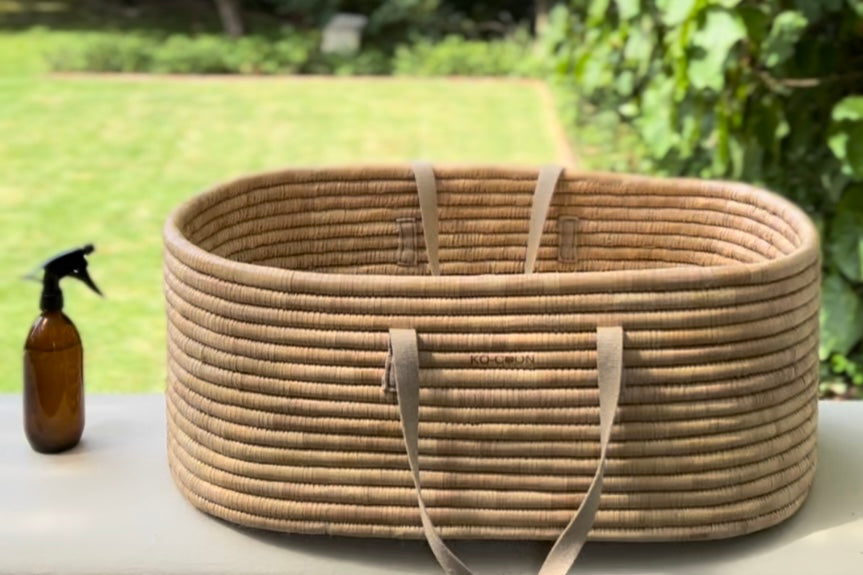
How to Clean Mold and Mildew from Wicker and Palm Moses Baskets or how to maintain them in top notch condition: A KO-COON Guide
Keeping your wicker and palm Moses baskets clean and free of mold and mildew is essential for ensuring the safety of your little one and maintaining their beauty.
Here’s a structured guide to help you:
✔️keep the mold and mildew away from your baskets, keeping them in perfect condition
✔️clean the
Seasons
Mold and mildew thrive in humid seasons. During these times, it’s essential to increase your cleaning frequency to prevent buildup. Regular maintenance is key to keeping your basket in top shape all year round.
Baskets that are used daily require more frequent cleaning. Regular use exposes them to more dirt and moisture, increasing the likelihood of mold and mildew growth.
Understanding the Humid Seasons in South Africa
South Africa’s diverse climate varies greatly across its regions. Knowing the humid seasons in different areas can help you take better care of your KO-COON Moses baskets and other products.
Cape Town (Western Cape)
• Humid Season: Winter (June to August)
• Characteristics: Cape Town experiences a Mediterranean climate with wet winters. Humidity is high during this season due to frequent rainfall.
West Coast (Western Cape)
• Humid Season: Winter (June to August)
• Characteristics: Similar to Cape Town, the West Coast has its humid season in winter with cooler temperatures and higher humidity due to rain.
Garden Route (Western Cape to Eastern Cape)
• Humid Season: Spring to Autumn (September to April)
• Characteristics: The Garden Route experiences higher humidity during these months, with the peak during late summer (January to March) due to its coastal and forested nature.
Durban (KwaZulu-Natal)
• Humid Season: Summer (November to March)
• Characteristics: Durban has a subtropical climate with high humidity in summer. It is warm and humid with frequent afternoon thunderstorms.
Johannesburg (Gauteng)
• Humid Season: Summer (November to March)
• Characteristics: Johannesburg experiences higher humidity during summer months, characterized by afternoon thunderstorms and warm temperatures.
Free State
• Humid Season: Summer (November to March)
• Characteristics: The Free State has a semi-arid climate but experiences higher humidity in summer, particularly during thunderstorms.
Limpopo
• Humid Season: Summer (November to March)
• Characteristics: Limpopo has a tropical climate with high humidity in summer. It is warm and experiences frequent rain during this season.
Other Regions
• Eastern Cape: Humid in summer (November to March) with coastal areas experiencing higher humidity.
• Mpumalanga: Humid in summer (November to March) with a subtropical climate.
• Northern Cape: Generally dry, but some regions like Upington can have higher humidity during late summer (February to March).
• North West: Humid in summer (November to March) with thunderstorms and warm temperatures.
Summary
• Winter Humidity: Western Cape (Cape Town, West Coast)
• Summer Humidity: KwaZulu-Natal (Durban), Gauteng (Johannesburg), Free State, Limpopo, Eastern Cape, Mpumalanga, North West
Understanding the humid seasons across different regions helps you take proactive steps to protect your KO-COON products from moisture-related damage.
TIP: Using a Hygrometer to Monitor HumidityA hygrometer is a handy device that measures the humidity levels in your home. Monitoring humidity is essential for preventing mold growth in your Moses basket and ensuring your baby’s health.
1. Ideal Humidity Levels: The ideal indoor humidity level is between 30% and 50%. Higher humidity levels can promote mold growth and make babies more susceptible to respiratory illnesses.
2. Risky Humidity Levels: Humidity levels above 60% are considered high and can increase the risk of mold growth and health issues.
3. Placement: Place the hygrometer in the room where the Moses basket is kept. Regularly check the readings to ensure the humidity levels are within the safe range.
4. Adjusting Humidity: Use a dehumidifier to lower humidity levels if they exceed 50%. Conversely, if the air is too dry (below 30%), a humidifier can add moisture to the air.
Whether it’s increased ventilation, using dehumidifiers, Hygrometers, or frequent cleaning, these practices ensure your baby’s environment remains safe and comfortable.
Moses Baskets GENERAL CARE TIPS
1. Regular Dusting: Use a soft brush or cloth to gently remove dust and debris from your Moses basket. Regular dusting helps prevent the buildup of dirt that can attract mold and mildew.
We recommend doing this once a week or every time when you change the fitted liner.
2. Vacuuming: Occasionally use a vacuum with a brush attachment to clean the basket’s crevices. This helps keep it free of dust and other particles that can cause deterioration over time.
We recommend doing this once every 2 weeks.
3. Sun Exposure: Place your basket in indirect sunlight regularly. Sunlight is a natural disinfectant and helps keep the basket dry, preventing mold and mildew growth.
4. Avoid Excessive Moisture: Keep your basket away from damp areas. Excess moisture can weaken the fibers and promote mold growth.
5. Air Circulation: Ensure good air circulation around the basket by placing it in a well-ventilated area. This is particularly important in humid environments.
EXTRA CARE TIPS for Humid Areas
Winter Humidity Care (June to August in Cape Town and West Coast)
During winter, areas like Cape Town and the West Coast experience high humidity due to frequent rain. Here’s how to protect your Moses basket:
1. Indoor Storage: Keep the basket indoors in a dry, well-ventilated area. Avoid placing it near windows or doors where it can be exposed to damp air.
2. Use Dehumidifiers: Place a dehumidifier in the room where the basket is stored to reduce moisture levels. This helps prevent mold and mildew growth.
3. Regular Checks: Inspect the basket frequently for any signs of mold or mildew. Early detection allows for prompt cleaning and prevents damage.
4. Drying: If the basket gets damp, dry it indoors using a fan or dehumidifier. Avoid placing it in direct sunlight, which may not be sufficient in high humidity conditions.
Summer Humidity Care (November to March in Durban, Johannesburg, and other areas)
In regions like Durban, Johannesburg, and Limpopo, summer brings high humidity due to warm temperatures and frequent rain. Follow these tips to keep your Moses basket in top shape:
1. Ventilation: Ensure the basket is placed in a well-ventilated area. Good air circulation helps keep it dry and prevents mold growth.
2. Regular Sun Exposure: Place the basket in indirect sunlight regularly to help it stay dry. Sunlight acts as a natural disinfectant.
3. Dusting and Vacuuming: Frequently dust and vacuum the basket to remove particles that can trap moisture.
4. Avoid Damp Areas: Keep the basket away from bathrooms, kitchens, and other areas with high humidity levels.
Care During the Rest of the Year (Spring and Autumn)
Spring and autumn in South Africa have varying weather conditions, making regular maintenance essential.
1. Balanced Maintenance: Continue regular dusting and vacuuming to keep the basket clean.
2. Regular Sun Exposure: Expose the basket to indirect sunlight to keep it fresh and dry.
3. Air Circulation: Ensure good air circulation around the basket to prevent any moisture buildup.
4. Seasonal Inspection: Perform a thorough inspection and cleaning before and after the humid seasons to prepare the basket for the changing weather conditions.
Inspect the basket regularly for signs of wear, mold, or mildew. Prompt cleaning and repairs can extend its lifespan.
HOW TO CLEAN YOUR MOSES BASKET
Recipe for Homemade Cleaning Solution
Ingredients:
• Equal parts white vinegar and water (1/2 cup with 1/2 cup)
• 1-2 drops of mild dish soap
• 1 tbsp of baking soda
What Not to Use
• Harsh Chemicals: Avoid using bleach or other harsh chemicals as they can damage the wicker and palm fibers. These materials are delicate and require gentle care.
• Excessive Water: Do not soak the basket, as too much water can weaken the material and cause further mold growth.
• Abrasive Tools: Hard brushes or abrasive scrubbers can damage the surface of the basket. Always opt for soft tools that won’t harm the fibers.
Tools Needed
• Soft brush
• Vacuum with brush attachment
• Soft cloths
• Spray bottle
Steps to Clean
1. Preparation:
• Take the basket outside to prevent mold spores from spreading indoors. Fresh air and sunlight can also help kill mold spores.
• Use a vacuum with a brush attachment to remove loose dust and debris.
• Prepare the solution: Mix the wet ingredients in a spray bottle. Only: vinegar, water, dishwashing liquid.
2. Application:
• Spray the homemade cleaning solution onto moldy or mildewed areas. Ensure the solution covers all affected spots.
• Let it sit for 15-20 minutes. This allows the solution to break down the mold and mildew effectively.
3. Scrubbing:
• Gently scrub the affected areas with a soft brush. Be careful not to damage the wicker or palm fibers. Gentle scrubbing helps remove the mold without harming the basket.
4. Rinsing:
• Wipe down the basket with a cloth dampened with clean water to remove the cleaning solution. This step is crucial to prevent any residue that might attract more mold.
5. Second Application
• Wipe with a damp cloth.
6. Drying:
• Allow the basket to air dry completely in a well-ventilated, sunny area. Proper drying is essential to prevent new mold growth. Avoid using artificial heat sources as they can damage the basket.
By following these care tips, steps and guidelines, you can effectively prevent and /or clean mold and mildew from your wicker and palm Moses baskets, ensuring they remain safe and beautiful for your little ones.
All our love - KO-COON team

